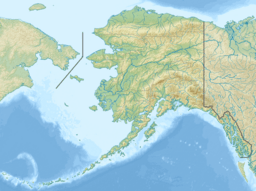Nugget Mountain facts for kids
Quick facts for kids Nugget Mountain |
|
|---|---|

Nugget Mountain, from southwest
|
|
| Highest point | |
| Elevation | 5,587 ft (1,703 m) |
| Prominence | 987 ft (301 m) |
| Isolation | 4.62 mi (7.44 km) |
| Parent peak | Spencer Peak |
| Geography | |
| Location | Tongass National Forest Juneau Borough Alaska, United States |
| Parent range | Coast Mountains Boundary Ranges Juneau Icefield |
| Topo map | USGS Juneau B-2 |
Nugget Mountain is a cool mountain in Alaska, United States. It stands about 5,587 feet (1,703 meters) tall. This mountain is covered in ice and snow, making it a "glaciated" peak. It's part of the Boundary Ranges, which are a section of the huge Coast Mountains.
Nugget Mountain is located near the southern edge of the Juneau Icefield. This is a massive area of glaciers and ice. The mountain is about 9 miles (14.5 kilometers) northeast of the city of Juneau. It's also found within the beautiful Tongass National Forest. Two creeks, Nugget Creek and Lemon Creek, carry water away from the mountain's slopes. The name "Nugget Mountain" was officially recognized in 1962 by the United States Geological Survey.
What is Nugget Mountain Like?
Nugget Mountain is a striking peak with a lot of ice. It's surrounded by other interesting natural features. For example, it's northwest of a peak called Split Thumb. It's also east of Bullard Mountain.
The mountain rises above the northeast part of Heintzleman Ridge. This ridge is another landform in the area. Nugget Mountain is also south of the Nugget Glacier. And it's west of the Norris Glacier. These glaciers are like slow-moving rivers of ice.
Weather and Climate at Nugget Mountain
The weather around Nugget Mountain is very cold and snowy. This area has a subarctic climate. This means it has long, cold winters with lots of snow. Summers are cool, not hot.
The weather patterns come from the Gulf of Alaska. When air from the gulf hits the Coast Mountains, it's forced to rise. This process is called orographic lift. As the air rises, it cools down and drops a lot of rain and snow. This is why the area gets so much precipitation.
Temperatures can get very low, sometimes dropping below -20 °C (-4 °F). With the wind, it can feel even colder, below -30 °C (-22 °F). If you want to see or climb Nugget Mountain, July usually has the best weather.


